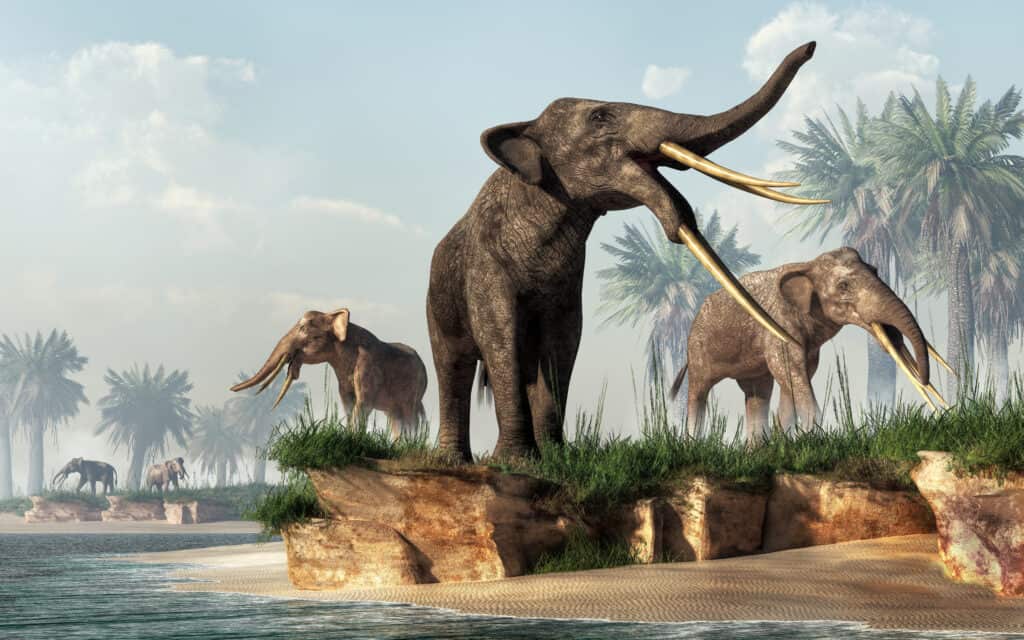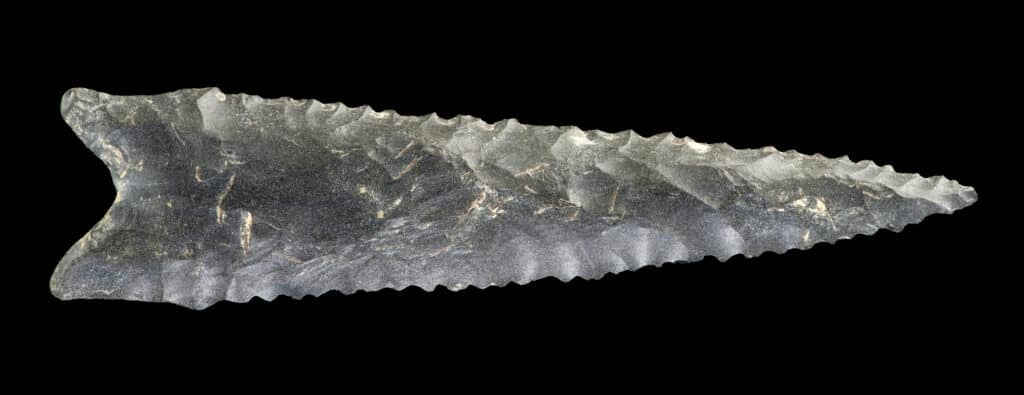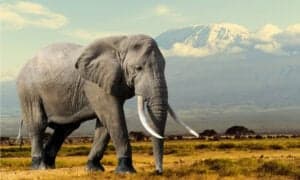Move over dinosaurs! After the end of the Cretaceous period, when the dinosaurs went extinct, prehistoric mammals began to develop and emerge. During the Eocene Epoch, which spanned 56-34 million years ago, gigantic ancient elephant-like animals began to roam through grasslands and forests. While similar in look to their modern descendants, ancient gomphotheres had four massive tusks that they used to defend themselves.
What is a Gomphothere?
Gomphotheres first appeared at the end of the Eocene Epoch, around 34 million years ago. They lived through the Pleistocene and early Holocene epochs. It is estimated that they lived as recently as 11,700 years ago. While they look a lot like modern-day elephants, they are actually from a different scientific family and went extinct as the ancestors of modern elephants continued to evolve.
These giant creatures lived in grasslands, forests, and marshes. Some were larger than others but all had trunks, similar to modern-day elephants. Some of their trunks were shorter and rigid, similar to a tapir. Others were much longer and agile. These trunks extended beyond the nose and above the upper lip. If you had lived 12,000 years ago, you would have likely mistaken these giant animals for elephants.

If you encountered a Gomphothere, you’d likely mistake it for a giant elephant.
©AndyElliott/Shutterstock.com
One notable difference between elephants and gomphotheres besides their size is the number of tusks. Elephants have two tusks. These are actually teeth. They extend down from their upper jaw. Elephants use their tusks to help them eat and for defense. Gomphotheres had the same two upper tusks. They also had two lower tusks that extended upwards.
Their jaws were similar to modern elephants. They were small relative to the size and number of their teeth. As larger teeth grew in, the smaller teeth moved to the front of their jaws. Gomphotheres are divided into trilophodont and tetralophodont groups. Trilophodonts had three plates in their molars, while tetralophodonts had four. Teeth and jaw structure and function were essential for the gomphothere’s survival and provide researchers a lot of information about how they lived.
What Did Gomphotheres Eat?
If you could time travel, you would be fortunate to encounter a gomphothere rather than a carnivorous ancient animal. These animals were herbivores, feasting on grass and other vegetation. Their preferred plants varied based on their environment. Gomphotheres that lived in the grasslands ate more grass, while their counterparts in the marsh ate marsh plants.

Gomphotheres likely lived near places with heavy vegetation and had an herbivore diet.
©Daniel Eskridge/Shutterstock.com
Their teeth and tusks also evolved to help them eat. Species of gomphotheres that lived in the marsh often had flatter and longer lower tusks to help them scoop water plants into their mouths at mealtime.
Many anthropologists believe that gomphotheres chewed by moving their jaws horizontally. This helped them eat, another important piece of information that tells researchers more about these amazing animals.
Habitat – Where and When It Lived
Gomphotheres were widespread and able to adapt to a variety of landscapes. Scientists discovered evidence that they lived on all continents except for Antarctica and Australia. They lived mostly in Africa, Eurasia, and North America. There, they fed on broad grasslands and other plants. Multiple types of gomphotheres developed, each uniquely suited to its environment and needs.
Landmasses shifted over the millions of years that the gomphothere roamed the earth. The animals migrated, developed, and found new territory during this time. Gomphotheres lived in South America in the early part of the Pleistocene, around 2.6 million years ago.

Forests, grasslands, and marshes were likely habitats for the Gomphothere.
©Juan Carlos Munoz/Shutterstock.com
Gomphotheres made their way to South America via the Isthmus of Panama. This landmass connects North and South America. It also separates the Atlantic and Pacific oceans.
These gigantic animals first appeared around 34 million years ago. Scientists have discovered evidence that places them in Africa during the Eocene Epoch, around 34 million years ago. Gomphotheres eventually became extinct, however. While researchers can’t pinpoint this time down to the exact year, it is estimated that gomphotheres were around as recently as 11,700 years ago.
Threats and Predators
With four ferocious tusks, you might think that gomphotheres were formidable predators. While they certainly looked the part, these giant ancient elephant-like animals were herbivores and used their tusks for defense and as tools. Not much is known about other animals that were threats to gomphotheres. Due to their large size, any other animal that would hunt and kill a gomphothere would need to be larger, have sharp teeth or claws, or hunt in packs.
One of the major threats to gomphotheres during their day was the change in habitat that impacted their feeding habits. Because they often ate their preferred foods, when these foods were gone, it made it difficult for gomphothere to get enough to eat. Because these animals are so large, they needed a lot of food to remain healthy.
Gomphotheres also existed alongside early humans. Researchers found evidence that the human tribe Clovis, an early group of hunter-gatherers in North America, hunted and killed gomphotheres. This tribe lived around 13,390 years ago and actively hunted, killed, and ate gomphothere. While not the widespread environmental impact of modern-day humans, ancient human populations hunting gomphothere were likely the most advanced predators hunting these ancient creatures.

There is evidence early human tribes like the Clovis people hunted gomphotheres, likely with weapons like these.
©W. Scott McGill/Shutterstock.com
Discoveries and Fossils – Where It Was Found
Gomphothere fossils have been discovered in many corners of the globe. Other than Antarctica and Australia, these creatures lived in every continent and climate. Fossils discovered in East Africa, Europe, Japan, and China all date to around 23 million years ago in the early Miocene era. During this time, they likely migrated to North America as well using the Bering Land Bridge that connected modern-day Alaska with Siberia. Before the ice age, animals such as the gomphothere and even people likely traveled across this landmass when it was exposed to come to North America.
Gomphothere fossils are common near ancient human sites. Evidence of weapon points alongside gomphothere bones shows that humans killed gomphotheres. At El Fin Del Mundo, an archaeological site in Sonora, Mexico, researchers found bone fragments of two young gomphotheres alongside multiple points from prehistoric humans known as Clovis hunter-gatherers. The points were discovered within the hunting site. Using carbon dating methods, scientists placed humans and gomphotheres in this location around 11,500 years ago. This discovery, made in 2007, helped scientists understand when and how gomphotheres lived.
Fossils include jawbones and teeth. This helps researchers learn more about how the gomphothere ate and one of the reasons why we know that they had tusks similar to modern elephants. Studying the wear on their teeth also helps scientists understand their diet of grasses and plants. Wear on their teeth also shows that some gomphotheres ate wood and tougher fibrous plants.
Extinction – When Did It Die Out?
Gomphotheres likely died out over time rather than as the result of one significant event. Their feeding habits may have become more specialized, moving away from grazing and a wider source of food. As gomphotheres evolved to favor just one or two main food sources, their numbers likely dwindled. Being hunted by humans may have also contributed to their decreasing numbers.
The last evidence of gomphotheres that researchers know places them in Eurasia around 11,700 years ago. This is the end of the Pleistocene epoch, also known as the Ice Age. As researchers continue to excavate sites, evidence of gomphotheres helps them understand when these animals went extinct.
While they look like modern-day elephants, the two animals are only distantly related. Both elephants and gomphothere belong to the Proboscidea order. Elephants are part of the Elephantidae family, which included ancient mammoths and multiple types of elephants. Gomphotheres were part of the Gomphotheriidae family.
Similar Animals to the Gomphotheres
Similar ancient and modern animals similar to gomphotheres include:
- Elephants: Modern elephants belong to a different family and are much smaller than ancient gomphotheres. Both have tusks, although elephants have two while gomphotheres had four.
- Mammoths: Now extinct, ancient mammoths lived during the same time period as gomphotheres. They both had trunks and tusks. Both mammoths and gomphotheres were large and hunted by humans for meat.
FAQ
When was the gomphothere alive?
Evidence of gomphotheres dates back to 34 million years ago at the end of the Eocene epoch. They migrated and evolved throughout most parts of the ancient world for millions of years. Gomphotheres eventually went extinct. The most recent evidence of gomphotheres dates to around 11,700 years ago, during the current Holocene epoch.
How big was a gomphothere?
By analyzing fossils, scientists are able to learn more about the size and structure of gomphotheres. Most were a similar size to modern Asian elephants, around 8-9 feet tall and between 6,000 and 9,000 pounds. Some species were larger, however.
Why did the gomphothere go extinct?
Researchers can’t say exactly what caused gomphothere to go extinct. They believe that a change in diet, changing food source availability, and hunting by humans all played a part in the decrease and eventual extinction of gomphotheres. Changing climate may have also been a contributing factor over time.
Is a gomphothere a type of elephant?
While they look a lot like elephants, gomphotheres are actually part of a different scientific family than elephants. Gomphotheres belonged to the Gomphotheriidae family, now all extinct. Elephants are part of the Elephantidae family. Now, just the Asian elephant and African elephant remain but in prehistoric times, other members included mammoths and other types of elephants. Both gomphotheres and elephants are part of the Proboscidea order. This classification includes animals with developed trunks and tusks, such as gomphotheres and elephants.
Were gomphotheres dinosaurs?
No, gomphotheres lived millions of years after the dinosaurs went extinct. Gomphotheres are an example of prehistoric mammals. While their taxonomic family is now extinct, they were part of the Proboscidea order and Mammalia class.
How many types of gomphotheres were there?
Scientists discover new information about ancient mammals every day but the currently known species of gomphothere include 11 genera of gomphotheres. These include:
- Blancotherium
- Gnathabelodon
- Gomphotherium
- Megabelodon
- Sinomastodon
- Rhynchotherium
- Cuvieronius
- Stegomastodon
- Haplomastodon
- Notiomastodon
- Eubelodon
The photo featured at the top of this post is © Daniel Eskridge/Shutterstock.com
Thank you for reading! Have some feedback for us? Contact the AZ Animals editorial team.







